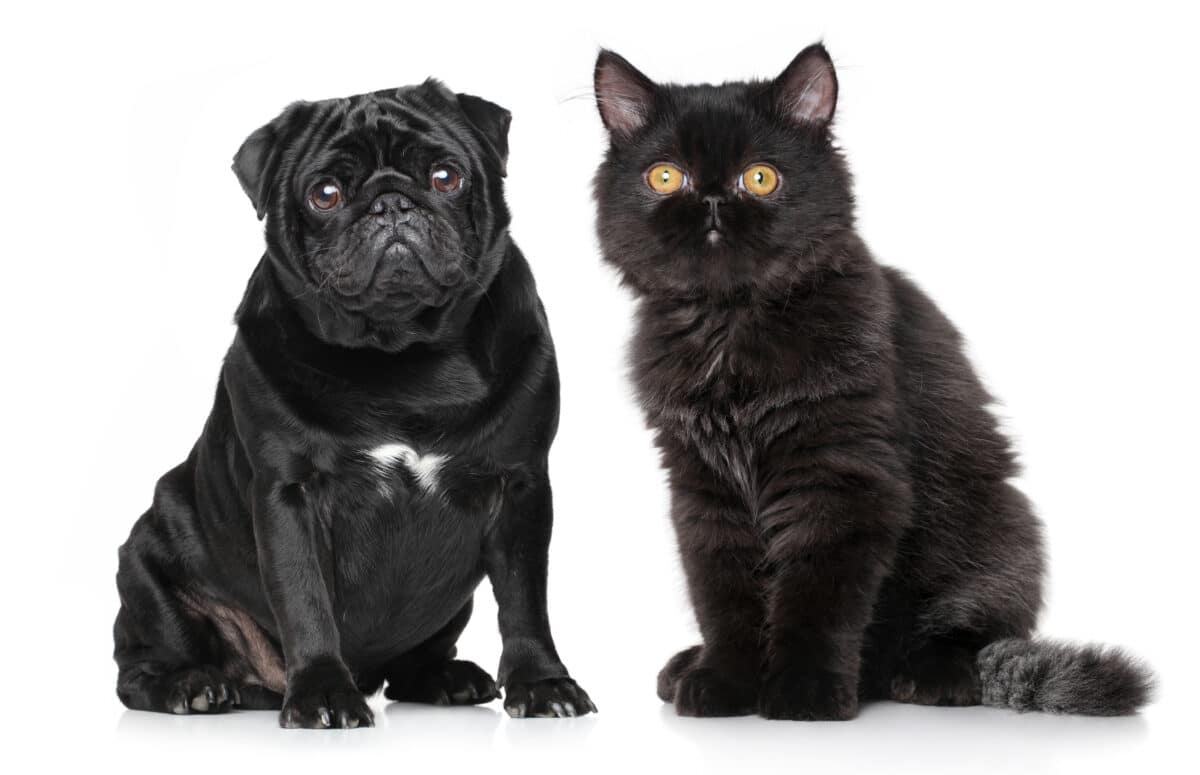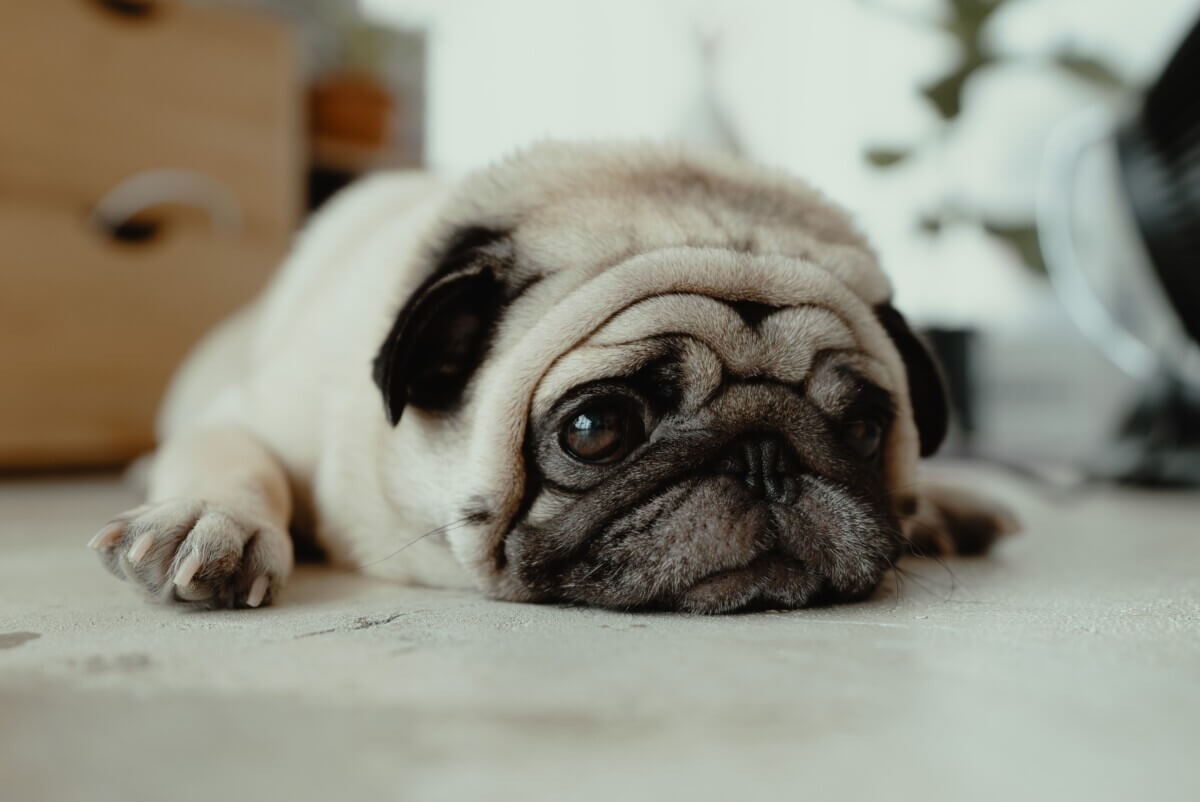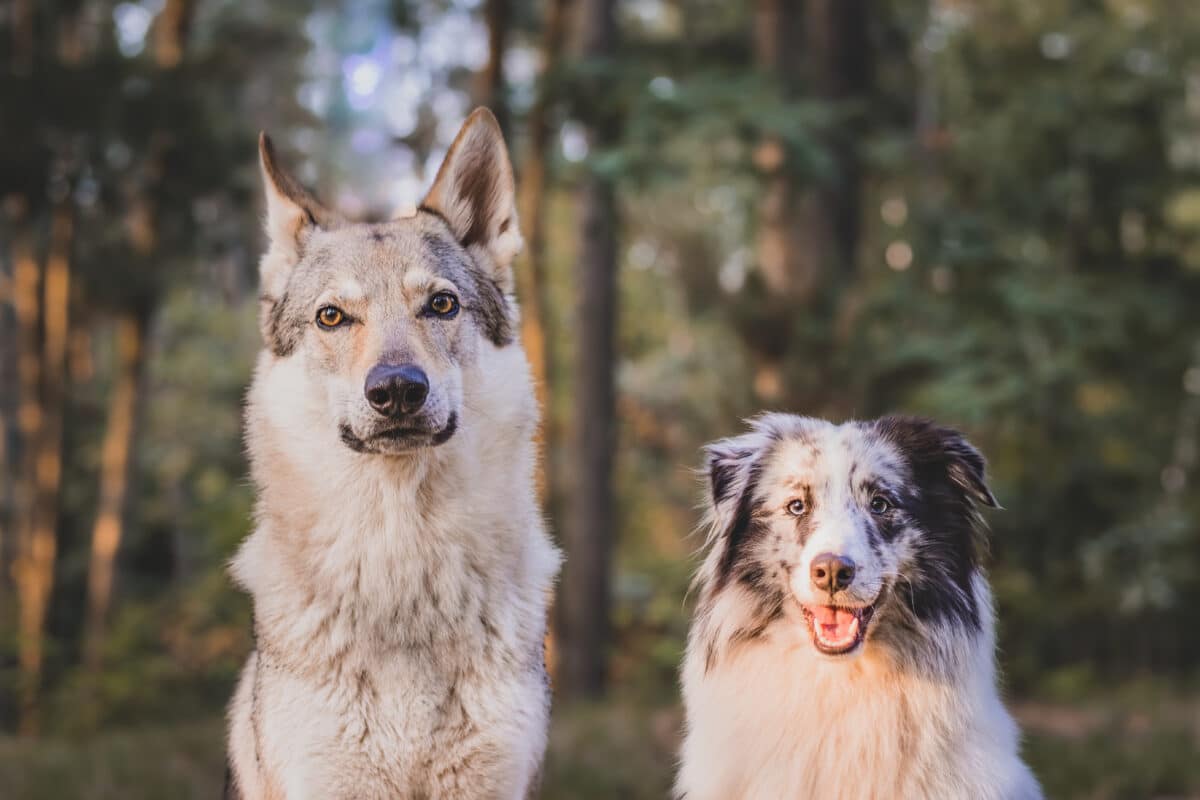
Breeds like Pugs and Persian cats have evolved to have similar skull shapes. (Jagodka/Shutterstock)
In a nutshell
- Despite being separated by millions of years of evolution, dogs and cats have evolved similar skull shapes due to human-driven selective breeding.
- This convergence has led to health problems, such as breathing and eye issues, in brachycephalic breeds like Pugs and Persians.
- Researchers analyzed 1,810 skulls and used 3D geometric morphometrics to quantify shape differences, revealing significant convergence between brachycephalic breeds in both species.
ITHACA, N.Y. — Dogs and cats might seem worlds apart, but scientists have discovered that our beloved pets have independently evolved nearly identical skull shapes despite being separated by 50 million years of evolution. This uncanny “copy-cat evolution” suggests our human preference for baby-like features has reshaped the very bones of our companion animals in strikingly similar ways.
A team of scientists from Cornell University and Washington University analyzed 1,810 skulls from domestic dogs, domestic cats, wild canids (the dog family), wild felids (the cat family), and other carnivores. Their findings, published in the Proceedings of the National Academy of Sciences (PNAS), show that breeds like Persian cats and Pug dogs have developed remarkably similar skull shapes despite evolving from ancestors with very different skull structures.
Researchers found that both cats and dogs have a surprising amount of variety in their skull shapes, even more than many other animals in their families. Due to artificial selection, some breeds from these two vastly different species now look so similar that they resemble each other more closely than their own ancestors or other members of their species, something never before documented in domesticated animals.
While dog breeds are known for having a lot of differences in size and appearance, domestic cats have often been thought of as more uniform. Yet the study reveals that the skull shapes of domestic cats vary just as dramatically as those of dogs relative to their wild ancestors. In fact, some domestic cats, particularly flat-faced breeds like Persians, have skulls that are more similar to those of Pugs than to wildcats.
How Human Preferences Shaped Pet Evolution

Human preferences for baby-like features in our pets is the driving force behind this. Breeders have selected for the same large-eyed, round-headed, short-muzzled traits in both cats and dogs, what scientists call the “baby schema” that triggers nurturing responses in humans. These preferences have shaped breeding standards for extremely brachycephalic (short-faced) breeds in ways that are nearly identical between species.
For example, the Cat Fancier Association’s standard for Persian cats requires a round, massive head with a profile where the eyes are prominent and the forehead, nose, and chin appear vertically aligned, with the nose centered between the eyes. Similarly, the American Kennel Club’s standard for Pekingese dogs calls for a massive topskull where the chin, nose, and brow align in one plane when viewed from the side, and where a horizontal line across the nose intersects just above the center of the eyes.
These breeding practices have not only caused cats and dogs to develop similar skulls, but also led to several cases of similar skull shapes within each species. Flat-faced dog breeds evolved at least twice—once in Asia (like the Pekingese) and again in Western breeds (like the English Bulldog). Similarly, brachycephalic cats evolved separately in Persian and American Burmese breeds.
To conduct the study, researchers used three-dimensional geometric morphometrics, a sophisticated mathematical approach to analyzing shape, to compare skull features. They placed 47 three-dimensional landmarks on each skull and used statistical analyses to quantify similarities and differences.
Extremely brachycephalic cats and dogs are much more similar to each other in skull shape than they are to their wild ancestors, with the difference being smaller between the two species than between wildcats and wolves.
While domestic dogs show greater skull shape diversity than domestic cats, wild felids (like lions, tigers, and cheetahs) actually show substantially more skull shape variation than wild canids (wolves, foxes, and other wild dog species).

The researchers discovered that wild cats have a lot of variation in their skull shapes, showing that even though dog breeds are highly diverse, wild dogs don’t actually have more potential for evolutionary change than cats.
This means that the limited variety of skull shapes in wild dogs isn’t because of genetic limits, but because natural selection favored certain shapes. Once humans took over the selection process through breeding, both cats and dogs quickly evolved extreme skull shapes.
The research also showed that cats and dogs took different paths to reach similar skull shapes. The differences between short-faced dogs and wolves highlight how much change was needed for dogs to evolve from their long-muzzled ancestors. Domestic cats, with naturally shorter muzzles, didn’t change as much in muzzle length but instead developed more bending in the angle between their forehead and muzzle.
Sadly, this has health implications. Extremely brachycephalic cat and dog breeds suffer from similar health problems, including breathing difficulties, eye issues, and dental problems. The researchers note that pressure is mounting to ban breeding of extreme brachycephalic individuals for animal welfare reasons, which could reverse this remarkable case of convergent evolution.
Nature took 50 million years to create the differences between cats and dogs, but humans needed just a few centuries to blur those lines through selective breeding. This research not only shows how flexible mammal development can be, but also raises important questions about our role in shaping animal evolution and the health issues our preferences for certain looks can cause.
Paper Summary
Methodology
Researchers collected three-dimensional measurements from 1,810 skulls, including 148 domestic cats, 677 domestic dogs, 69 wildcats, 287 wolves, 185 specimens from 23 other canid species, 350 members of 33 felid species, and 94 specimens from 93 other carnivore species. They captured 47 three-dimensional landmarks on each skull and used geometric morphometric analysis to investigate shape variation. Principal components analysis (PCA) was performed on the covariance matrix of the Procrustes shape coordinates to identify patterns of variation. The research team calculated two main measures of variability for each group: Procrustes shape variance (PV) and maximum Procrustes shape distance.
Results
The study found that both domestic cats and dogs have diversified greatly compared to their wild ancestors, with dogs showing somewhat more shape variability than cats. Extremely brachycephalic breeds of cats and dogs have converged to such an extent that they are more similar to each other than either is to their wild ancestors. This convergence has occurred multiple times independently, with brachycephaly evolving at least twice in dogs and separately in Persian and American Burmese cats. Unexpectedly, wild felids showed substantially greater skull shape diversity than wild canids, contradicting the assumption that canids are inherently more evolvable than felids. The research also revealed that different evolutionary pathways (changes in muzzle length versus cranial flexion) led to similar brachycephalic morphologies in cats and dogs.
Limitations
The study focused only on extant (living) species and did not incorporate fossil data from extinct felids and canids, which may have had even more diverse morphologies. The sampling of domestic cat breeds may underestimate their true diversity, as some extreme modern phenotypes might not be represented in the skull collections used. Additionally, while the study identified convergent skull morphologies, it did not extensively investigate the genetic mechanisms responsible for these similarities.
Funding/Disclosures
The authors declared no competing interests in the paper. No specific funding information was provided in the excerpts shown.
Publication Information
The study titled “Copy-cat evolution: Divergence and convergence within and between cat and dog breeds” was published in the Proceedings of the National Academy of Sciences (PNAS) in 2025 (Vol. 122, No. 0, e2413780122). The paper was contributed by Jonathan B. Losos, received July 12, 2024, accepted March 4, 2025, and reviewed by Emma Sherratt and Nobuyuki Yamaguchi. The article is distributed under Creative Commons Attribution-NonCommercial-NoDerivatives License 4.0 (CC BY-NC-ND).







